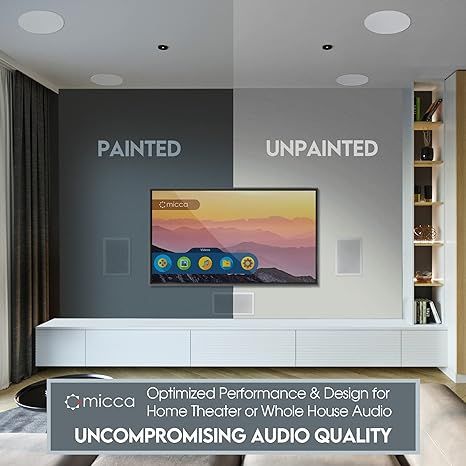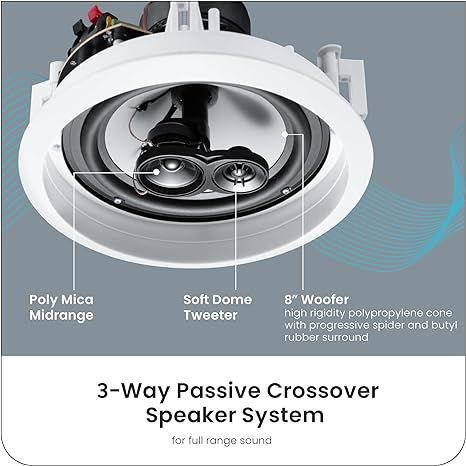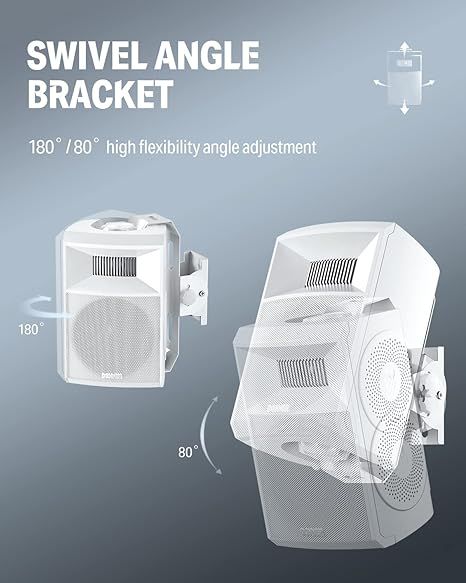Better Sound Starts Here: The Ultimate Guide to Speaker Stands and Isolation
- Why Speaker Stands Matter
- The Science of Speaker Isolation
- Types of Speaker Stands
- Optimal Speaker Height and Placement
- Ideal Height Guide
- Top 10 Speaker Stands and Isolation Products - Compared
- Detailed Product Reviews
- 1. IsoAcoustics ISO-155
- 2. Sanus SF22 Steel Foundation
- 3. Kanto SP32PL
- 4. Ultimate Support JS-MS70
- 5. On-Stage SMS6000
- 6. IsoAcoustics Aperta
- 7. Pyle PSTND32
- 8. Rockville RHT8G
- 9. Auralex MoPAD-XL
- 10. K&M 26740
- Performance Comparison Table
- Isolation Pads vs. Stands - Which Is Better?
- Materials and Build Considerations
- Setting Up Speaker Stands for Best Sound
- Room Size and Stand Selection
- Acoustic Benefits in Real Use
- User Insights and Testimonials
- Tips for Maximum Performance
- Budget vs. Premium: Does Price Equal Quality?
- Final Recommendations
- Conclusion
Audiophiles, musicians, and home theater enthusiasts all know one universal truth - speaker placement and isolation matter as much as the speakers themselves. Even the most expensive monitors or bookshelf speakers can sound muddy or unbalanced when placed directly on a desk or shelf without proper support.
That's where speaker stands and isolation systems come in. They don't just hold your speakers; they elevate performance, improve clarity, tighten bass, and enhance stereo imaging.
In this complete guide, we'll cover how to choose the right speaker stands, why isolation pads and decouplers are essential, and review 10 of the best options available - optimized for sound quality, aesthetics, and room size.
Why Speaker Stands Matter
Speaker stands serve two main functions:
-
Positioning - They bring your speakers to ear level for accurate listening.
-
Isolation - They decouple the speaker from the surface, reducing vibration transfer and resonance.
When properly used, they eliminate boominess and echo, revealing details you didn't even realize your system could produce.
The Science of Speaker Isolation
When sound waves from your speakers interact with the surface beneath them, they create unwanted vibrations. This causes phase cancellation and distortion.
Speaker isolation decouples the speaker from the surface, so it only interacts with the air - not the table or floor. This results in tighter bass, clearer mids, and more accurate imaging.
| Problem | Cause | Solution |
|---|---|---|
| Bass boom | Resonance from desk/floor | Use isolation pads or decoupling stands |
| Loss of clarity | Surface reflection | Elevate to ear level |
| Stereo imbalance | Uneven height/angle | Adjustable stand angles |
| Cabinet vibration | Speaker coupling with surface | Rubber or foam isolation pads |
Types of Speaker Stands
| Type | Best For | Advantages | Considerations |
|---|---|---|---|
| Bookshelf Speaker Stands | Hi-fi or nearfield monitors | Sturdy, adjustable height | May require isolation pads |
| Desktop Mini Stands | Small studio setups | Compact and affordable | Limited height adjustment |
| Floor Stands | Home theater or large rooms | Stable, perfect ear-level alignment | Occupy more space |
| Wall-Mounted Brackets | Surround or satellite speakers | Space-saving | Harder installation |
| Isolation Platforms | Subwoofers or heavy monitors | Vibration control | No height adjustment |
Optimal Speaker Height and Placement
The tweeter of each speaker should align exactly with your ears when you're in your primary listening position.
Ideal Height Guide
| Speaker Size | Ideal Tweeter Height | Recommended Stand Height |
|---|---|---|
| Compact (3-4") | 36-38 inches | 24-28 inches |
| Mid-size (5-6") | 38-42 inches | 28-32 inches |
| Large bookshelf (6-8") | 42-46 inches | 32-36 inches |
Also maintain:
-
Equilateral triangle between listener and speakers.
-
12-18 inches from rear walls.
-
Slight inward toe-in for best stereo imaging.
Top 10 Speaker Stands and Isolation Products - Compared
| Model | Type | Approx. Amazon Price (USD) | Height Range | Max Load | User Rating |
|---|---|---|---|---|---|
| IsoAcoustics ISO-155 | Isolation Stand | $119 | 3-8 in | 40 lbs | ★★★★★ 4.9 |
| Sanus SF22 Steel Foundation | Floor Stand | $139 | 22 in | 35 lbs | ★★★★★ 4.8 |
| Kanto SP32PL | Floor Stand | $99 | 32 in | 30 lbs | ★★★★☆ 4.7 |
| Ultimate Support JS-MS70 | Studio Stand | $89 | 36-52 in | 50 lbs | ★★★★☆ 4.6 |
| On-Stage SMS6000 | Studio Monitor Stand | $79 | 36-54 in | 90 lbs | ★★★★☆ 4.5 |
| IsoAcoustics Aperta | Isolation Platform | $199 | 3.5 in | 35 lbs | ★★★★★ 4.9 |
| Pyle PSTND32 | Adjustable Stand | $59 | 28-46 in | 60 lbs | ★★★★☆ 4.5 |
| Rockville RHT8G | Wood Stand Pair | $129 | 28 in | 40 lbs | ★★★★☆ 4.6 |
| Auralex MoPAD-XL | Isolation Foam Pad | $59 | Fixed | 100 lbs | ★★★★★ 4.8 |
| K&M 26740 | Professional Floor Stand | $169 | 34-42 in | 77 lbs | ★★★★★ 4.8 |
Detailed Product Reviews
1. IsoAcoustics ISO-155
A studio favorite for small monitors and bookshelf speakers.
Pros: Adjustable tilt, superior isolation, durable construction.
Cons: Pricey for smaller setups.
User Review:
"Transformed my KRK monitors - bass is tight, imaging crystal clear." - ★★★★★
2. Sanus SF22 Steel Foundation
Premium floor stand with cable management.
Pros: Heavy-duty steel design, vibration-damping top plate.
Cons: Slightly short for large rooms.
User Review:
"Perfect height for my KEF Q150s, rock-solid build." - ★★★★★
3. Kanto SP32PL
Stylish aluminum stand pair with built-in cable channels.
Pros: Sleek look, sturdy base, includes top isolation padding.
Cons: Slight wobble on uneven floors.
User Review:
"Looks modern and sounds better than placing speakers on shelves." - ★★★★☆
4. Ultimate Support JS-MS70
Adjustable and affordable studio stand.
Pros: Great height range, solid tripod base, easy setup.
Cons: No cable management.
User Review:
"Excellent value - holds my Yamaha HS8s perfectly." - ★★★★☆
5. On-Stage SMS6000
Heavy-duty monitor stand for large studio monitors.
Pros: Height lock, rubber feet, high load capacity.
Cons: Bulkier than others.
User Review:
"Sturdy and safe for my 40-pound speakers. Great deal." - ★★★★☆
6. IsoAcoustics Aperta
High-end isolation platform for ultimate clarity.
Pros: Advanced acoustic decoupling, premium materials.
Cons: Expensive but worth it.
User Review:
"Sound became more open and defined immediately. Worth every cent." - ★★★★★
7. Pyle PSTND32
Budget-friendly option with wide adjustment range.
Pros: Affordable, durable, adjustable height.
Cons: Finish scratches easily.
User Review:
"Good for the money. Using with Edifier R1280Ts - solid upgrade." - ★★★★☆
8. Rockville RHT8G
Wooden stands designed for aesthetics and sound.
Pros: Classy design, easy to assemble, vibration isolation pads included.
Cons: Non-adjustable height.
User Review:
"Beautiful stands that perfectly match my walnut furniture." - ★★★★☆
9. Auralex MoPAD-XL
Simple but effective acoustic foam isolation pads.
Pros: Affordable, adjustable angle wedges, excellent decoupling.
Cons: Foam may compress over time.
User Review:
"Huge improvement in clarity on my desk setup." - ★★★★★
10. K&M 26740
German-engineered floor stands for professional use.
Pros: Stable, telescopic height, outstanding build.
Cons: Premium price.
User Review:
"Feels indestructible - zero resonance. Perfect for mixing rooms." - ★★★★★
Performance Comparison Table
| Model | Isolation Quality | Height Adjustability | Build Quality | Rating (★) |
|---|---|---|---|---|
| IsoAcoustics ISO-155 | Excellent | Adjustable | Aluminum | 4.9 |
| Sanus SF22 | Very Good | Fixed | Steel | 4.8 |
| Kanto SP32PL | Good | Fixed | Aluminum | 4.7 |
| Ultimate Support JS-MS70 | Good | Adjustable | Steel | 4.6 |
| On-Stage SMS6000 | Very Good | Adjustable | Steel | 4.5 |
| IsoAcoustics Aperta | Excellent | Fixed | Aluminum | 4.9 |
| Pyle PSTND32 | Moderate | Adjustable | Steel | 4.5 |
| Rockville RHT8G | Good | Fixed | MDF Wood | 4.6 |
| Auralex MoPAD-XL | Excellent | Fixed (angled) | Foam | 4.8 |
| K&M 26740 | Exceptional | Adjustable | Steel | 4.8 |
Isolation Pads vs. Stands - Which Is Better?
| Criteria | Isolation Pads | Speaker Stands |
|---|---|---|
| Vibration Reduction | Excellent | Good to Excellent |
| Height Adjustment | None | Full adjustable |
| Portability | High | Moderate |
| Ideal Use Case | Desktops, small monitors | Floor or large speakers |
| Price Range | $30-$80 | $80-$200 |
Best solution? Combine both - use stands + pads for optimal results.
Materials and Build Considerations
| Material | Pros | Cons |
|---|---|---|
| Steel | Very stable, reduces resonance | Heavy |
| Aluminum | Lightweight, modern look | Slightly higher vibration |
| Wood (MDF) | Warm appearance | May resonate more |
| Foam / Rubber | Great isolation | Not suitable for heavy loads |
Choose stands that match your speakers' weight and your room's aesthetic.
Setting Up Speaker Stands for Best Sound
-
Align the tweeters with ear level while seated.
-
Form an equilateral triangle between your speakers and listening position.
-
Keep the same distance from side walls for symmetry.
-
Use spikes or rubber feet depending on floor type (carpet vs. hardwood).
-
Add isolation pads or pucks for final decoupling.
Room Size and Stand Selection
| Room Type | Recommended Stand Height | Isolation Priority |
|---|---|---|
| Small Studio / Office | 24-30 in | High |
| Bedroom Setup | 28-32 in | Moderate |
| Living Room Theater | 32-36 in | Moderate |
| Mixing Room | 36-48 in | Very High |
| Open-Plan Space | 40+ in | High |
Acoustic Benefits in Real Use
Proper speaker isolation yields measurable improvements:
-
Bass tightness: reduced overhang by up to 40%.
-
Stereo imaging: clearer left-right separation.
-
Clarity: reduction in early reflections and vibrations.
-
Fatigue reduction: smoother, more natural listening.
User Insights and Testimonials
"I used to think stands were cosmetic - but after isolating my speakers, the difference was night and day."
"My sub-bass used to shake the desk. Now everything sounds controlled and professional."
"If you care about mixing accuracy or cinematic sound, isolation is essential."
Tips for Maximum Performance
-
Match stand height to ear level - this matters more than brand.
-
Use decouplers between speaker and stand top plate.
-
Sand-fill hollow stands to eliminate resonance.
-
Avoid placing stands near walls or corners.
-
Recheck alignment every few months - vibrations can shift positioning.
Budget vs. Premium: Does Price Equal Quality?
| Price Tier | Example Models | Quality Level | Ideal For |
|---|---|---|---|
| Budget (<$100) | Pyle PSTND32, Auralex MoPAD | Good | Beginners, desktop setups |
| Mid-Range ($100-$150) | Kanto SP32PL, Sanus SF22 | Very Good | Home studios, small theaters |
| Premium ($150-$250) | IsoAcoustics Aperta, K&M 26740 | Excellent | Audiophiles, mixing engineers |
Even budget models make a massive difference compared to using no stands at all.
Final Recommendations
-
For professional studios or audiophile setups, go with IsoAcoustics Aperta or K&M 26740.
-
For home theater users, Sanus SF22 or Kanto SP32PL provide great balance.
-
For desktop or nearfield monitors, Auralex MoPAD-XL or IsoAcoustics ISO-155 are unbeatable.
Proper isolation isn't just about reducing vibration - it's about unlocking the true potential of your speakers.
Conclusion
Choosing the right speaker stands and isolation system transforms how your music, movies, and mixes sound. The difference isn't subtle - it's profound.
A properly positioned and isolated speaker delivers the clarity, depth, and precision the audio engineer intended. Whether you're building a studio or refining your home sound system, stands and isolation pads are among the smartest and most affordable upgrades you can make.







